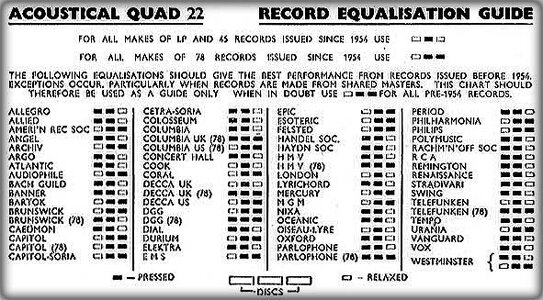I was in the hi fi business for many years. I used to have a Linn LP12 / Naim tri-amp / Linn Isobarik setup. Over the years I’ve witnessed the debate between transistors and valves, CD’s and vinyl, hi fi perfection at any cost, but one thing that has never been mentioned or discussed in pre-amplifier or integrated amplifier reviews is the adherence to the RIAA curve at the phono input stage. For those who are mystified, since the inception of the LP as a sound carrying format, all discs have been mastered and stamped with pre-emphasis applied to try and alleviate certain inherent problems with the discs themselves. De-emphasis is then applied at the phono input stage to counteract the effect. However, I have never seen any review where the accuracy of the de-emphasis curve is tested. This could account for many sonic differences between pre-amplifiers.
RIAA curve
- Thread starter TrevorS
- Start date
You are using an out of date browser. It may not display this or other websites correctly.
You should upgrade or use an alternative browser.
You should upgrade or use an alternative browser.
ToppingSMSL
Well-known member
Audio Science Review measure this:

 www.audiosciencereview.com
www.audiosciencereview.com

 www.audiosciencereview.com
www.audiosciencereview.com

Phono Amplifier Review Index
A few things were niggling me in this forum, and I thought I might be able to help. Some of the reviews of phono amps aren't listed in this forum - they're in the Amplifiers Forum instead - the next level up. That means it's easy to overlook some of the reviews. Similarly, some of the reviews...
 www.audiosciencereview.com
www.audiosciencereview.com

Cambridge Audio Duo Phono Stage Review (Updated)
This is an updated review of the Cambridge Audio Duo phono preamplifier. It is on kind loan from a member and costs US $349. The Duo has a solid build and is attractive to boot for its price. Back panel shows independent sets of inputs for moving magnet and coil cartridges: I like the...
 www.audiosciencereview.com
www.audiosciencereview.com
Vincent Kars
Well-known member
Maybe you can find the article mentioned below but 1979 is before internet.....
Stanley Lipshitz put a cat among the pigeons in the June 1979 issue of the Journal of the Audio Engineering Society with an unprecedentedly detailed examination of the circuits used to apply RIAA/IEC deemphasis. He concluded that many of these were in error as a result of incorrect design equations being applied, or because the effects of other time constants in the circuit, and/or the influence of amplifier loop gain, were ignored. The corollary was another round in the nascent objectivist/subjectivist struggle in which it was claimed that many of the disparities heard between different amplifiers were due to nothing more exotic than significant departures from flat frequency response.
https://www.stereophile.com/content/cut-and-thrust-riaa-lp-equalization-page-2
Vincent Kars
Well-known member
nopiano
Well-known member
Welcome to the forum, Trevor!
Hifi News and Stereophile test phono stages too. You must have become out of touch with audio not to have seen either of them!
I recall years ago that tests actually showed the RIAA curve, but with very few of us understanding what it should look like it’s more sensible to show the outcome. Hence a smooth line, with probably a roll off below 20Hz is desirable.
In fact there was just such a graph in Stereophile’s review of the new Quad 33/303 that I was reading last night. However, mine was a paid subscription copy, but it’s already on their website for free. See Fig 9…
 www.stereophile.com
www.stereophile.com
PS. For everyone else, the Reviewer Reviewed box out of the same article is a great reminder of how reviewing has evolved.
Hifi News and Stereophile test phono stages too. You must have become out of touch with audio not to have seen either of them!
I recall years ago that tests actually showed the RIAA curve, but with very few of us understanding what it should look like it’s more sensible to show the outcome. Hence a smooth line, with probably a roll off below 20Hz is desirable.
In fact there was just such a graph in Stereophile’s review of the new Quad 33/303 that I was reading last night. However, mine was a paid subscription copy, but it’s already on their website for free. See Fig 9…
Quad 33 preamplifier & Quad 303 power amplifier Quad 33 Measurements | Stereophile.com
Sidebar 4: Quad 33 Measurements I performed a complete set of tests on the Quad 33 preamplifier with my Audio Precision SYS2722 system. Looking first at the 33's performance as a line preamplifier, all the inputs and outputs preserved absolute polarity, ie, were noninverting. The balanced input...
PS. For everyone else, the Reviewer Reviewed box out of the same article is a great reminder of how reviewing has evolved.
Last edited:
daytona600
Well-known member
If you have a budget RIAA , turnover hz can be constantly adjusted
RIAA only one of 100s ( Recording Industry Association of America )
Early bob dylan records sound better with Columbia than with RIAA
View: https://www.youtube.com/watch?v=0-AW6lZLcuA

RIAA only one of 100s ( Recording Industry Association of America )
Early bob dylan records sound better with Columbia than with RIAA

ToppingSMSL
Well-known member
nopiano
Well-known member
That Quad table is surely 70 years ago? Hardly of relevance today, though a fascinating piece of memorabilia or for the fanatical archivist?If you have a budget RIAA , turnover hz can be constantly adjusted
RIAA only one of 100s ( Recording Industry Association of America )
Early bob dylan records sound better with Columbia than with RIAA
View: https://www.youtube.com/watch?v=0-AW6lZLcuA
View attachment 9557
good_enough
Well-known member
As @nopiano says above, stereophile frequently has RIAA curve analysis in its reviews. If what you mean by 'never seeing' this info is you 'never see in WHF' then I'm afraid WHF is not a great place to look for vinyl playback. Use a reference cart in comparing turntables? Use a reference TT in comparing carts? All far too much like hard work for WHF .
TRENDING THREADS
-
-
Question I have decided to add a pair of floorstanding speakers to my setup and need help choosing?
- Started by Gel Man
- Replies: 31
-
-
-
-

Space.com is part of Future plc, an international media group and leading digital publisher. Visit our corporate site.
© Future Publishing Limited Quay House, The Ambury, Bath BA1 1UA. All rights reserved. England and Wales company registration number 2008885.
